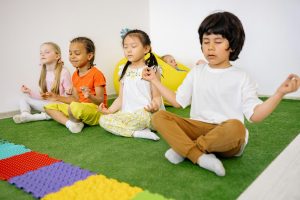Practical Mindfulness Exercises for Classroom Stress Reduction
As the education system continues to evolve and the demands on teachers and students increase, it’s no surprise that stress levels in the classroom are also on the rise. From lesson planning to grading to managing disruptive behavior, the daily tasks of teaching can quickly become overwhelming and lead to burnout. This is where the concept of mindfulness comes in, offering practical and effective tools for reducing stress and creating a more peaceful and productive classroom. In this article, we’ll delve into some practical mindfulness exercises that teachers can incorporate into their daily routine to combat classroom stress and create a more positive learning environment.
The Power of Mindfulness
Mindfulness is the practice of being fully present in the current moment, without judgment or distraction. It allows us to tune out the noise of our busy minds and focus on the here and now. By incorporating mindfulness into our daily lives, we can reduce stress, improve mental well-being, and enhance our overall quality of life. This is especially important for teachers who are constantly juggling multiple tasks and responsibilities.
Mindful Breathing
Breathing is something we all do naturally without much thought. However, deep and intentional breathing can have a powerful impact on our mental and physical well-being. As teachers, we can incorporate mindful breathing exercises into the classroom to help both ourselves and our students reduce stress levels. One simple exercise is to encourage students to take three slow and deliberate breaths before starting a new activity or at the beginning of each class. This helps to calm the mind and bring focus to the present moment.
Meditation
Meditation is a popular and effective mindfulness practice that has been used for centuries to reduce stress and promote relaxation. It involves training the mind to achieve a state of inner peace and stillness. As teachers, we can lead our students in short guided meditations during class or incorporate mindful breathing exercises into quiet reflection time. This can help students to clear their minds, reduce anxiety, and improve their ability to concentrate.
Gratitude Practice
Gratitude is a powerful emotion that can shift our focus from what we lack to what we have. By incorporating a gratitude practice into our daily routine, we can cultivate a more positive mindset and reduce stress levels. As teachers, we can encourage our students to start each day by writing down three things they are grateful for. This can help to shift their perspective and set a positive tone for the rest of the day.
Yoga and Movement
Yoga and other physical activities like walking or dancing are great ways to incorporate mindfulness into our daily routine. These activities not only help us to relax and reduce stress, but they also promote physical well-being. As teachers, we can lead our students in simple stretches or movements to help them release tension and increase their mindfulness. This is also a great way to break up long periods of sitting and improve focus and concentration.
Journaling
Journaling is a powerful tool for self-reflection and awareness. As teachers, we can encourage our students to keep a daily journal where they can reflect on their thoughts, emotions, and experiences. This helps to cultivate mindfulness by bringing attention to the present moment and promoting self-reflection. It can also be a creative outlet for students to express themselves and reduce stress levels.
Be Present and Lead by Example
Finally, one of the most important elements of bringing mindfulness into the classroom is for the teacher to lead by example. Teachers can incorporate mindful practices into their own daily routines and openly talk to their students about the benefits of mindfulness. This not only helps to build trust and rapport with students but also encourages them to incorporate these practices into their own lives.
In conclusion, by incorporating these practical mindfulness exercises into the classroom, teachers can create a calmer and more positive learning environment for themselves and their students. Remember, mindfulness is a skill that takes time and practice to develop, but the benefits are well worth the effort. So, take a deep breath, clear your mind, and start incorporating these simple mindfulness exercises into your daily routine to reduce stress and promote well-being in the classroom.










